This is a Petri 1.9 Color Corrected Super, a 35mm rangefinder camera made by Kuribayashi Shashin Kōgyō K.K. starting in 1960. This camera is part of Kuribayashi’s long running series of 35mm rangefinders starting with the Petri 35, which were produced between 1954 and 1961. There are a huge number of variations in this series, with changes to the shutter, some with f/1.8, f/1.9, f/2, and f/2.8 lenses, and others with minor cosmetic differences. The basic operation and features of the entire series are very similar, however. Later models like this one feature the company’s “Green-O-Matic” rangefinder which overlays a large green filter over the rangefinder and frame line window to increase contrast within the main viewfinder.
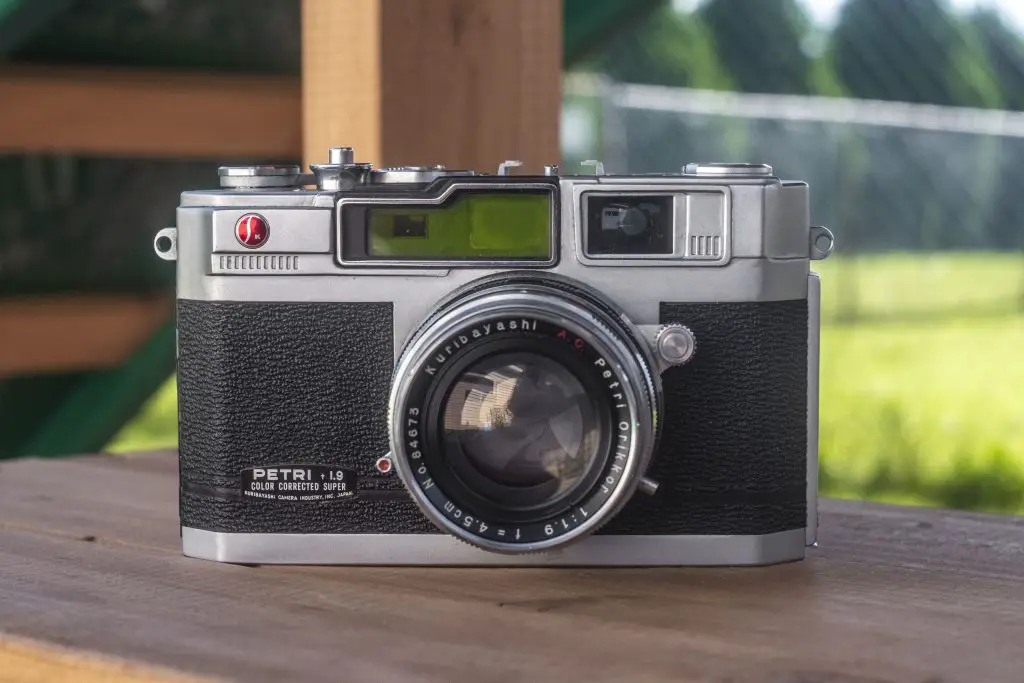 Film Type: 135 (35mm)
Film Type: 135 (35mm)
Lens: 4.5cm f/1.9 Petri Orikkor coated 6-elements
Focus: 3 feet to Infinity
Viewfinder: Coincident Image Coupled Rangefinder w/ Auto Parallax Corrected Projected Frame Lines
Shutter: Copal SV Leaf
Speeds: B, 1 – 1/500 seconds
Exposure Meter: None
Battery: None
Flash Mount: Coldshoe and M and X Flash Sync
Weight: 728 grams
Manual (similar model): http://www.cameramanuals.org/petri_pdf/petri_1_9.pdf
Manual (in Japanese): https://mikeeckman.com/media/Petri19ManualJapanese.pdf
How these ratings work |
The Petri 1.9 Color Corrected Super is an unassuming 35mm rangefinder from the late 1950s and early 60s built by a company not known to make cameras that hold up well today. The camera is more compact than typical rangefinders of the day and incredibly well built with almost perfect ergonomics. The Green-O-Matic system isn’t any better than other tinted rangefinder windows, but works well. Finally, the six element Orikkor lens delivers fantastic results that are as good as any other quality fixed lens rangefinder. This is an outstanding camera in every way and while it doesn’t do anything that more expensive rangefinders can do, I can’t find a single fault in it. Highly recommended. | ||||||
| Images | Handling | Features | Viewfinder | Feel & Beauty | History | Age | |
| 2 | 2 | 1 | 2 | 2 | 1 | 20% | |
| Bonus | +1 for perfect handling, ergonomics, and performance, the complete package | ||||||
| Final Score | 13.0 | ||||||
History
Kuribayashi was founded in Tokyo, Japan in 1907 by Kuribayashi Yōji and made a variety of photographic equipment like tripods and dark boxes. The company would eventually make it’s first camera in the 1920s known as the Speed Graphic. It was a large format plate camera that could be custom ordered with a variety of lenses and shutters.
In the 1930s, Kuribayashi made many folding roll film cameras such as the Semi First and First Six. These cameras were very similar to designs by German companies such as Balda and Welta and often were sold without any identifying marks. Many of Kuribayashi’s early products were sold by third parties under a variety of names. One of the more common names used was First Camera Works which was sold by a third party called Minagawa Shōten. For this reason, it can be incredibly difficult to identify an early Kuribayashi made product.
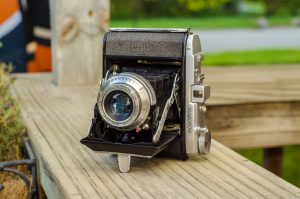
During World War II, at least one of Kuribayashi’s offices in Tokyo was destroyed. There isn’t much information about what the company was doing around this time, but like most other Japanese optical companies, they were likely ordered by the Occupation Forces to begin producing items for commercial sale in an effort to rebuild Japan’s economy.
It wouldn’t be until 1949 when Kuribayashi would regroup and change names to K.K. Kuribayashi Shashin Kikai Seisakusho and move to Chiyodo, Toyko. At this time, the company also ended it’s ties with Minagawa Shōten and would cease selling products under the First Camera Works name. The company would release two new lines of cameras, one called the Kuribayashi Karoron which would be a lower end line of folding cameras loosely based on the Zeiss-Ikon Ikonta, and a TLR called the Petriflex.
Petri’s first 35mm rangefinder was released in 1954, simply called the Petri 35. It was a fairly modest model featuring a 45mm f/2.8 Orikkor lens and a simple shutter with a top speed of 1/200. The camera didn’t stay simple for long however, as Petri continually evolved the model, improving the design with more features, faster lenses, and better shutters.
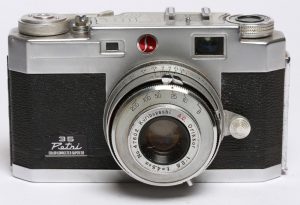
An improved version of the Petri 35 called the Petri Automate would debut in 1956, and featured Kuribayashi’s first sub f/2 lens on a 35mm camera, the six-element f/1.9 Orikkor. The Automate also came with a more advanced Carperu shutter with a top speed of 1/500, a folding rewind crank, and larger viewfinder and rangefinder windows. The Petri Automate interestingly, is the only one of this series of cameras produced by Petri that actually had an official model name. All of the rest of the cameras in the series were either identified by the number 35, the speed of the lens, or unofficially by a feature of the camera.
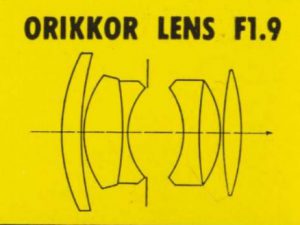
The Automate was a short lived model as the very next year, Petri would abandon it’s top plate design and larger viewfinder windows, and update the original Petri 35 with different lenses and shutters. At least three different variants were available, all identified by the lens they had attached. The Petri 2.8 and Petri 2.0 would come first in 1957, and the Petri 1.9 in early 1958. According to drawings in both the manuals of the Petri 2.0 and Petri 1.9, the 6-element Orikkor appears to have the same design with the 1.9 being a refinement of the earlier lens to give it a slightly larger maximum aperture. According to Jim McKeown, the f/2.0 model was introduced to fill an apparent gap between the high and low end models.
Continuing with their tradition of annually improving their models, in 1958 an updated Petri 2.8 was released with the words “Color Corrected Super” beneath the model name on the front of the camera. These new models were similar to the cameras from the year before, but added two new features. The first was that the projected frame lines within the viewfinder now had automatic parallax correction, and externally, the presence of a green window in front of both the rangefinder window and the openings for the projected frame lines. Kuribayashi would describe this feature as the “Green-O-Matic” system and in the years since their release, some collectors began to refer to these cameras as the Green-O-Matic, but that name was never used by Kuribayashi in any promotional material, nor were the cameras called that in their original instruction manuals.
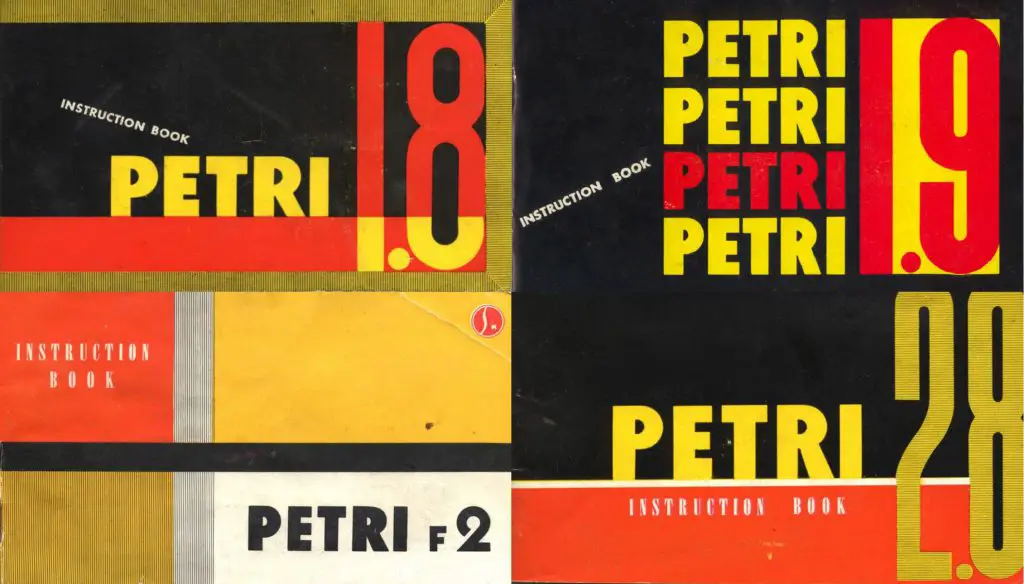
In 1959, models with both f/1.8 and f/1.9 lenses were released. Like the ones equipped with the f/2.8 lens, these were indicated on the front of the body as “Petri 1.8 Color Corrected Super” and “Petri 1.9 Color Corrected Super”. Unlike the f/1.9 and f/2 Orikkors which appear to have the same lens formula, the f/1.8 Orikkor is different as the instruction manual for that camera shows a completely different arrangement of the lens’s six elements. The Petri 1.8 Color Corrected Super was produced in very small numbers and may have been a Japanese only model as all American advertisements from the time only show the f/1.9 and f/2.8 models.
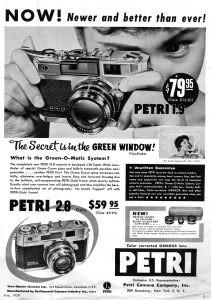
When they were sold in the United States, the Petri 1.9 and 2.8 Color Corrected Supers sold for $79.95 and $59.95 respectively. When adjusted for inflation, these prices compare to $525 and $700, putting them right in line with what a mid-level camera would sell for today.
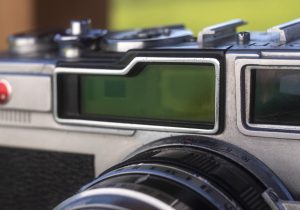
There are a number of variants of the Petri 1.9 Color Corrected Super. Some cameras have the letter “F” in front of the number 1.9 and some have a star. The only difference between the two is the shutter. Models with the star have a Copal SV shutter just like the Petri 1.8 Color Corrected Super, and those with the “F” have a Copal MXV. According to a post on rangefinder forum from 2012, models with the star have higher serial numbers, suggesting that they came later.
A third version features cosmetic changes on the front and top of the camera. Where earlier cameras had a larger single piece of green glass that covered both the rangefinder window and the window for the projected frame lines, and a small black frame around it, a later variant has two smaller pieces of green glass covering both windows, and a much larger black frame that extends to the top of the camera. This second version has the Petri logo outlined in white paint surrounded by a black background, whereas the earlier version has the Petri logo without any color, engraved into the chrome top plate.
There does not appear to be any other changes made to the camera other than these cosmetics, and since it was done near the end of the camera’s production, perhaps they did this as a way to freshen up the look of the camera in an effort to sell remaining inventory prior to the release of the upcoming Petri 7 in 1961.
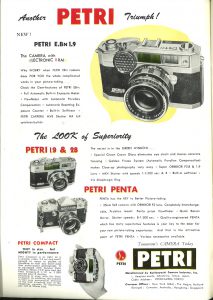
Yet another variant was sold sometime in 1960, as the Petri E.Bn which had a large round uncoupled selenium exposure meter on the front plate with a meter read out on the top. The letters “E.Bn” seemingly were short for “Electronic Brain” and it was Petri’s first camera to feature a meter. The English language advertisement to the right suggests this model was exported to the United States.
Finally, the last variants of these cameras were those sold by the DeJur-Amsco Corporation, a photographic goods importer out of New York. Both the EB.n and the third variant of the 1.9 Color Corrected Super models were labeled as DeJur Petris both on the front and top plates of the cameras.
In 1961, the Petri 7 rangefinder would be released, with a new and more angular body, and a coupled selenium exposure meter surrounding the taking lens. The Petri 7 rangefinder would continue to be referred to as “Color Corrected Super” on the front plate of the camera and feature green tinted rangefinder glass. Strangely, in 1964 came the similarly named, but entirely unrelated SLR called the Petri Flex 7 which had a prominent circular selenium exposure meter above the lens and in front of the prism, similar to the Zeiss-Ikon Contarex SLR.
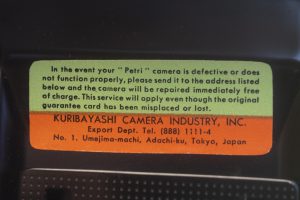
Kuribayshi would change it’s name in 1962 to Petri Camera K.K. as it was increasingly common for Japanese optics companies to identify themselves by the name of their most popular product.
In the years that would follow, Petri cameras would become overlooked in the overly crowded Japanese camera market. Market leaders like Nippon Kogaku (Nikon), Canon, and Minolta became top tier companies while a huge number of others had to fight to stay alive in the middle of the market. In an effort to stay profitable, Petri’s products became increasingly more basic and less expensive. Quality control would suffer, and by the 1970s, Petri would become an OEM supplier of cameras rebadged by other companies such as Argus, Carena, and Exakta.
Today, most Petri cameras do not enjoy a good reputation as reliable cameras. This is largely a result of the massive number of lower quality SLRs and rangefinders that the company churned out in the 1960s and 1970s, but the earlier products like the Petri Color Corrected Supers seem to be built to a higher quality standard, and are quite good. For the ambitious collector willing to give one a chance, the response is generally pretty positive. With their excellent lenses, good looks, and simple all mechanical controls, you could do a lot worse than a Kuribayashi produced Petri.
My Thoughts
I’ve had a few Petris come my way over the years, most of them were SLRs and a couple of their later models like the Petri Racer which I previously reviewed, but they all lived up to their reputations as unreliable cameras either breaking completely or having enough issues that shooting them wasn’t a pleasant experience.

Then one day, in what can only be described as “Infectious GAS”, I was talking to Johnny Sisson while visiting Central Camera in Chicago and he started frothing at the mouth over his “Green-O-Matic” Petri. Having a lukewarm opinion of the brand, at first I didn’t bite, but Johnny kept going on and on about his camera, and how it has an almost “Maitani” level of thoughtfulness to the design. I thought that maybe he had been drinking some tap water from Central’s basement, so I initially dismissed him as having lead poisoning, but Johnny kept going on and on about this little camera, even mentioning it multiple times on his Classes Lenses Podcast, and finally, he collaborated with Hamish from 35mmc and posted a full review of his camera, and admitting my own weaknesses, I finally succumbed and picked up one of my own, and then another, and then another, and then another.
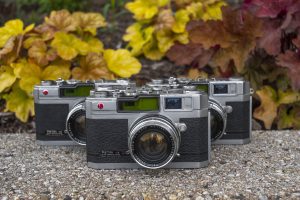
It was clear that this little rangefinder was not made by the same company as the other Petris I had handled before. From the moment you pick it up, this camera does not feel like one made by a “B-List” Japanese optics company. The quality of the camera suggested it could have been produced by Canon, Konica, or Minolta. The controls are all exactly where they should be, which wouldn’t be much of a surprise except at the time of the Petri’s release each of those three companies had been experimenting with film advance levers on the bottom (Canonet 19), on the left side (Konica III), and those with shutter speed wheels prominently on the top plate (Minolta A, A2, Super A) so a late 1950s camera with everything in a “normal” location wasn’t a given.
The Petri 1.9 Color Corrected Super is also surprisingly compact. Comparing it to early Japanese rangefinders, the Petri is closer in size to a Canonet QL17 or Minolta Hi-Matic E, but with a weight of 728 grams (1.6 lbs), it definitely doesn’t feel like those cameras. This is an entirely metal camera with no obvious use of plastic anywhere on the exterior surface, or even within the film compartment.
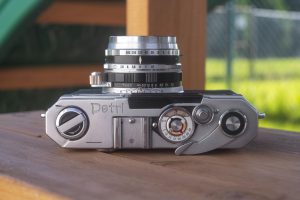
Up top, from left to right is the folding rapid rewind knob, accessory shoe, combined film reminder dial and exposure counter, shutter release, and film advance lever. The film reminder dial is a bit more elaborate than those on other cameras, showing a film speed scale from ASA 5 to 800 and both a black and colored arrow which can be rotated to indicate the type and speed of film entered. The exposure counter is automatic resetting, and the shutter release is externally threaded for a “Leica style” shutter release cable.
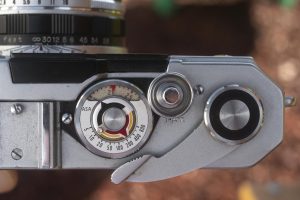
The film advance lever has a total movement of a little more than 180 degrees, and has the perfect amount of resistance. It is neither too stuff, nor too loose. Another neat feature of the lever is that for quick action shots, after winding and firing the shutter, you do not need to bring it all the way back to the start position to wind it again. With the Petri 1.9 Color Corrected Super, you can wind the lever all the way and hold it there, fire the shutter then back it off about 90 degrees and then wind it again without starting over and you’ll be able to fire the shutter again. This is far from a rapid sequence motorized drive, but it’s a neat feature for times where you need a quick sequence of shots.
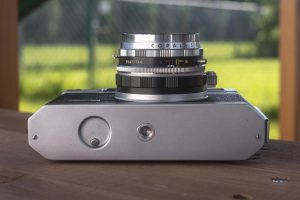
There’s not much to see on the bottom plate, which is a good thing as there is often a correlation between cameras with cluttered bottom plates and poor ergonomics. The only things here are the rewind release button and centrally located metal 1/4th inch tripod socket. As I say often in these reviews, the location of the tripod socket as close as possible to the middle of the camera is ideal as it helps stabilize the camera when mounted to a tripod.
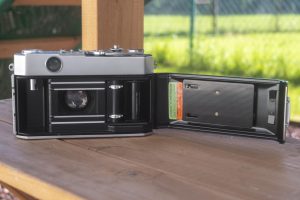
The right hinged film door opens to reveal an ordinary looking film compartment. Film transport is from left to right onto a single slotted and fixed take up spool. As I mentioned earlier, the entire film compartment is made of metal, even the take up spool which was one of the first parts of older cameras that started to be made in plastic. The film door has an over sized and dimpled film pressure plate that keeps consistent pressure on the film as it travels entirely through the camera. Although a small detail, this type of pressure plate isn’t found in entry level cameras, and speaks to Kuribayashi’s attempt at making a quality product.
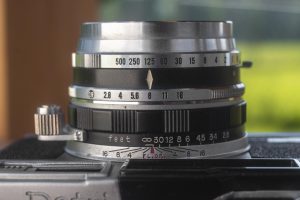
Looking down at the top of the shutter, we see perhaps one of my favorite features of the Petri 1.9 Color Corrected Super….actually, the lack of a feature. Unlike pretty much every single other German or Japanese rangefinder from the mid 1950s to the early 1960s, the Petri is the only example I’ve used that does not have any sort of coupled EV or LV scale. There’s no coupling of the shutter speed and f/stops around the lens to throw you off when you want to make quick adjustments for different exposures. I’ve spoken endlessly about my disdain for this feature on other cameras. Some companies implement the LVS in a way that’s better than others, but no matter how good, they always get in the way and slow me down.
What I find interesting is that there might have been a time where the lack of this feature might have been a “con” to a camera like this, as people had come to expect them on cameras of this era, but for me, they never help. I don’t need a camera to link the shutter speed and aperture size for me and with the Petri, you are free from such restrictions.
Both shutter speed and aperture rings are narrow, but are separated by a thick black band which makes rotating one easy to do without accidentally moving the other. The focusing ring is closest to the body and has a prominent handle that is easily reached by your left hand while holding the camera. Finally, in a very small, but very much appreciated detail, the self timer lever on the Copal-SV shutter is near the 8 o’clock position around the lens, keeping it away from your left hand. On many other leaf shutter cameras of this era, the self-timer lever is often at the bottom of the shutter, or even off to the left side where it can be accidentally triggered by your focusing hand. Having the self-timer lever in this position all but eliminates any chance of accidentally activating it.

The Petri’s viewfinder is basic, only featuring the frame lines for the 4.5 cm lens, but they are automatically parallax corrected, whcih means they move in a downward angle when focusing the lens to minimum focus. The beamsplitter, mirrors, and glass on my example were all very clean and made for an extremely pleasant and contrasty view. The “Green-O-Matic” system that tints the rangefinder patch and frame lines green actually looks more yellow to me and while it is contrasty, it’s no better or worse than others I’ve seen. While the green glass gives the front of the camera a very distinct look, it seems more like a marketing gimmick than an effective feature, but at least it’s not any worse.
Without having shot a single frame in the Petri 1.9 Color Corrected Super, I feel as though I was well on my way to Johnny Sisson’s level of “fanboy-ism” for this camera. It’s a solid and sturdy all metal camera that’s compact and smaller than most 35mm rangefinders of the day, it has an excellent arrangement of controls without any annoying LV system that plagues other cameras, it’s got a bright and easy to use parallax corrected viewfinder, an uneventful film compartment with an over sized pressure plate, and a fast f/1.9 Orikkor lens which has a reputation as an excellent performer. What else do you need?
DeJur Petri 1.9 Color Corrected Super
In the process of writing this article, I was donated yet another Petri 1.9 Color Corrected Super, this time though, it was the DeJur variant which appears to be based off the third variant with the redesigned black top plate. Compared to the regular Petri, all of the controls are in exactly the same locations, the viewfinder is just as green, and there were no problems with the shutter. I would say that they are identical, except when I put it on my kitchen scale, the DeJur version was 20 grams lighter. Certainly not a huge difference, but it suggests there might be some internal changes to the camera making up the difference.
I did not shoot the DeJur as it was too similar to the original to really have anything worthwhile to say, but here are some pictures of it side by side with the camera I used for this article.
My Results
I knew that when it came time to shoot the Petri Color Corrected Super, I wanted to honor the “Color” in the name and take it out and make some colorful photographs but summer had already drawn to a close and my color photography shooting opportunities are slim here in the fall, so one day when my family went to a fall festival in Lowell, Indiana, I loaded up a roll of fresh Fuji 200 and took the Petri with me.
Prior to shooting this Petri 1.9 Color Corrected Super, I had shot a Petri Racer and Petri Flex V. Both cameras had operational issues but worked long enough for me to get an idea of the optical performance of each camera’s lens. It was clear to me that for whatever quality control issues there might have been at the company, their ability to make lenses with world class optics had not faltered.
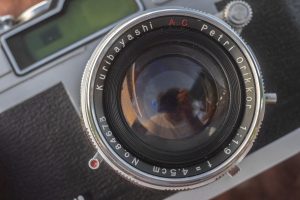
The same held true with this camera as the images from that first roll were all spectacular. Image sharpness from corner to corner was excellent. Contrast was nice and rendered color images that were neither blown out nor hazy. The 6-element Orikkor lens is as good as any other 35mm lens with comparable specs.
Of course there’s more to a camera than it’s lens, and the Petri exceeded there as well. The viewfinder and rangefinder on this example was as clear and bright as any I’ve seen. I did not miss focus on a single image on the roll, and even my less interesting shots of my children running around came out nicely in focus. The shutter seems to be working correctly at the speeds which I shot it which is notable as shutters have been the primary Achilles’s Heel on every other Petri camera I’ve used.
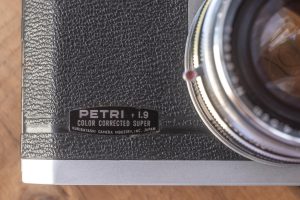
For a guy like Johnny Sisson who works in one of the world’s oldest camera stores and has the opportunity to handle hundreds of cameras every day, you’d think it would take a really special camera to endear itself as well as the Petri 1.9 Color Corrected Super has. I can honestly say that everything Johnny has said about this camera is spot on.
There is nothing fundamentally unique about it that dozens of other camera’s can’t do. Many 35mm rangefinders were made in the second half of the 20th century with good ergonomics and excellent lenses, and for that, the Petri 1.9 Color Corrected Super isn’t really that noteworthy, but for me, it’s biggest success was in how uneventful the shooting experience is. Shooting the Petri is natural from the first time you handle one. I often comment in my reviews about a feature that I probably would get used to if I shot the camera a bunch of times, but that doesn’t apply here. Handling the Petri 1.9 Color Corrected Super is natural the moment you first pick it up.
The camera simply flies under the radar while shooting as it does everything it should without getting in the way. In collector’s groups that don’t involve myself or Johnny, I don’t hear about too many people championing these cameras too much. Of course like any half century old camera, picking one up in perfect working order might require a bit of cleaning, but that’s not exactly a detriment unique to Petri. I see these cameras for sale at bargain prices all the time, certainly beneath those by other brands, and if you’re willing to take a chance on a brand that hasn’t always inspire confidence among collectors today, you might be pleasantly surprised, as I was, with the result.
Related Posts You Might Enjoy
External Links
http://camera-wiki.org/wiki/Petri_Color_Corrected_Super
https://www.rangefinderforum.com/forums/showthread.php?t=116647
https://w.atwiki.jp/petri/pages/17.html
https://thespendypencil.wordpress.com/petri-1-9-super-color-corrected-rangefinder/
https://www.35mmc.com/13/07/2018/petri-1-9-color-corrected-super-type-iii-review/
https://www.casualphotophile.com/2014/09/21/petri-f1-9-camera-review/

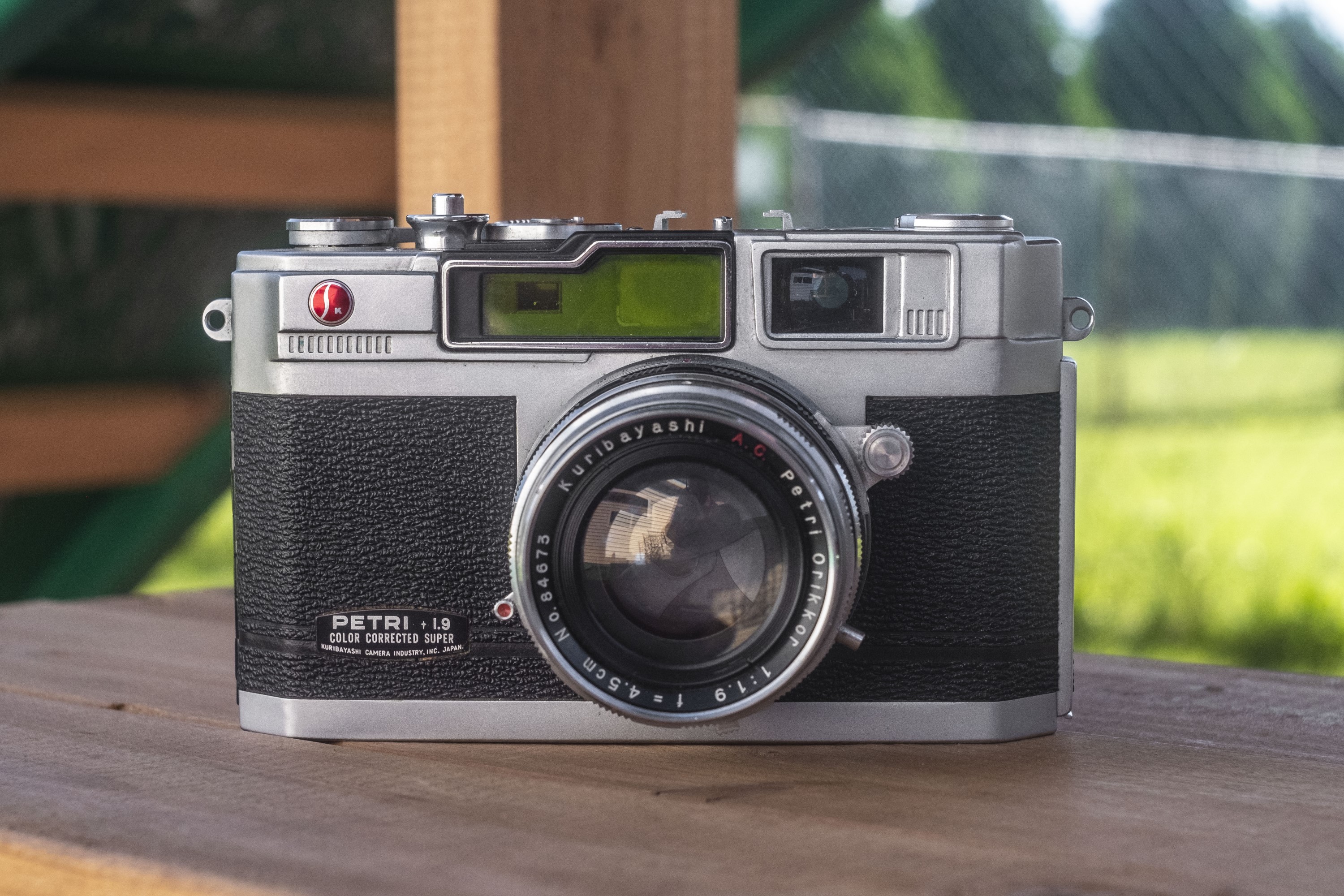
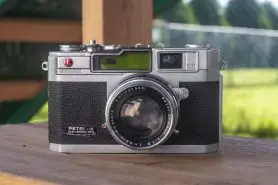
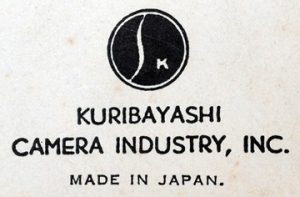
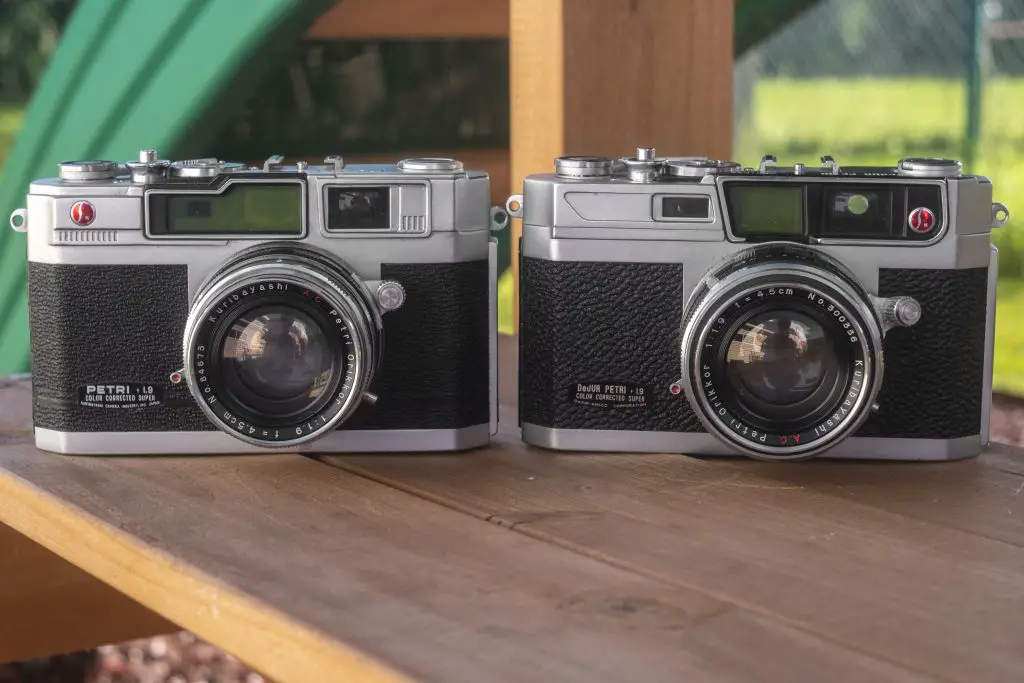
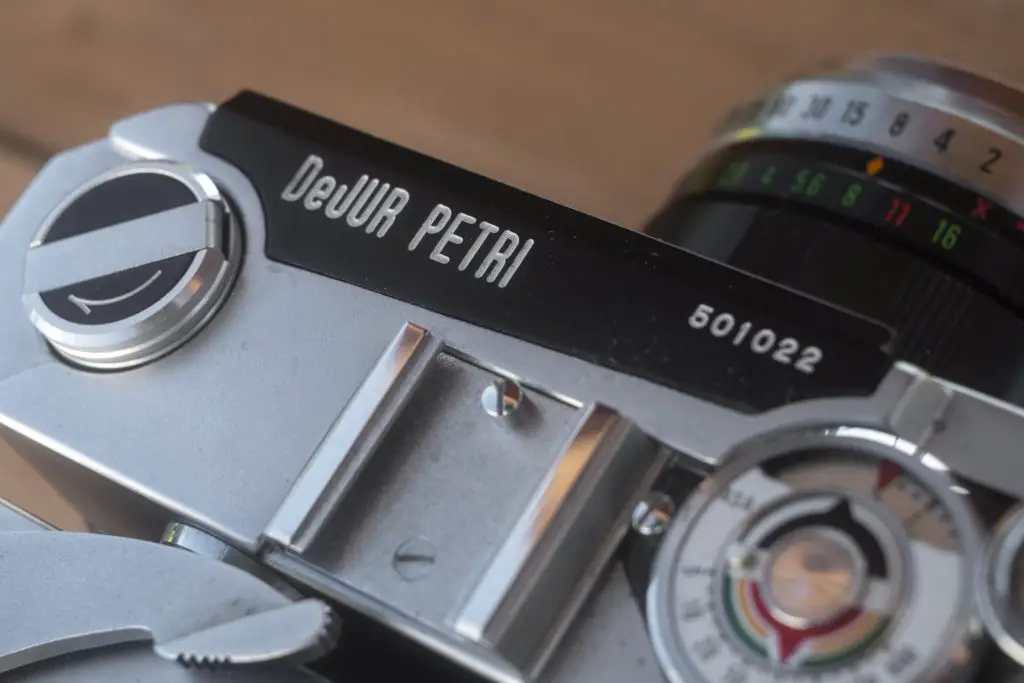
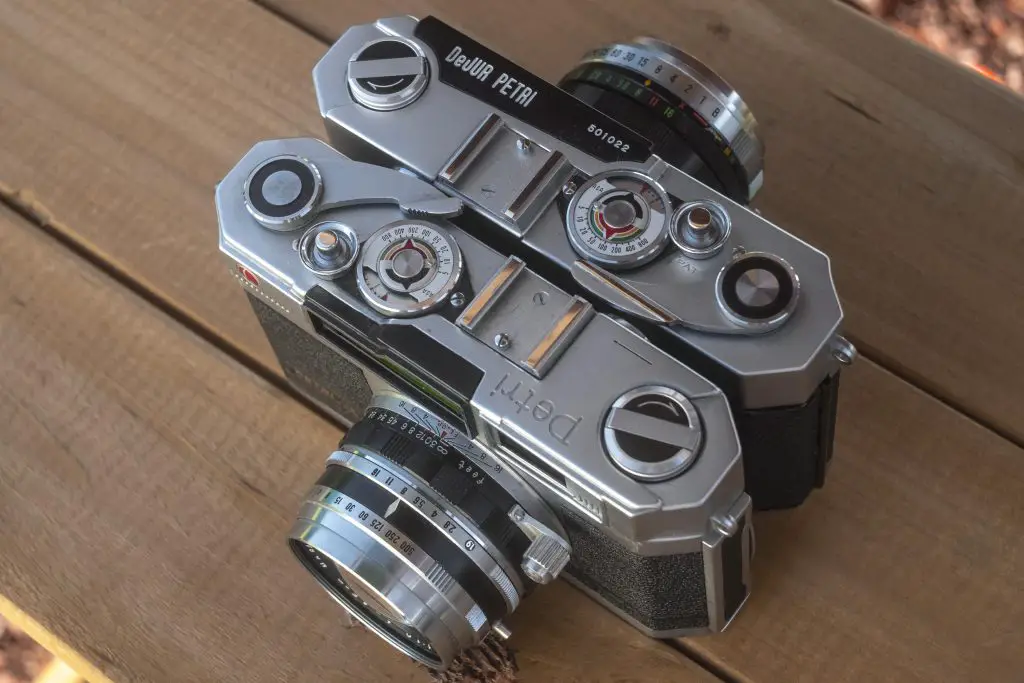














A good looking camera and that lens has character!
Agreed on both points. My only regret is only having the time to shoot one roll of film in this. It’s on my radar for a second roll, but getting through all these reviews takes time! 🙂
This is a proud day for the Green-O-Matic Cult! I’m glad you enjoy this camera so much, Mike. The images in your review look great and in my experience these CCS lenses have a unique look to them in terms of color rendering.
Haha! I’m glad you approve, and don’t mind me including you in my review! 🙂
I have the 2.8 version and although the lens on mine needs some attention overall it is a really nice camera to use and the shutter is super quiet. I don’t know why Petri cameras aren’t more highly regarded as they are very capable it seems to me.
Great write up! I’ve been wondering for a while about ditching the M2/summilux and getting an all-metal fixed-lens rangefinder and spending the difference on film. The challenge has been finding a good alternative, having tried the Olympus 35SP and not getting on well with the plastic and size. This looks like a viable option! Now to find one…
I don’t have the 35SP, but I do have the Olympus 35LC which uses the same exact body, and I can tell you that I much prefer the smaller size and ergonomics of the Petri over the Olympus. Image quality wise, they’re on par, as Olympus made terrific lenses too! I definitely recommend looking for a nice Petri. Once you hold one, even if it needs some work, you should see the appeal in it.
A well researched article on the Petri. I concur with your remarks about the quality construction, it is quite obvious on my Petri 2.8 Greenomatic. I haven’t used it yet, as the Yashica 35 (you previously reviewed) is still my favourite simple non-folder 2.8 camera.
Thanks for this post. I bought my 1st Petri 2.8 CC Super in 1961 on a navy destroyer. I still have it even tho it died several years ago. Last week I bought 2 more identical 2.8 CC supers. In my opinion it is a nice camera. I look forward to using them. one will have to be serviced. The other appears to be working well now. Jerry.
Mike, My Petri 2.8 CC Super has A C in red letters on the front of the lens. Any Ideas what it means?
The red C is for “coated”. It was common in the 50s and 60s for lens makers to emphasize the color coating the lens has which made them ideal for color film.
Mike, Any idea where I can get service for my Petri 2.8 CC Super rangefinder?
I dont know of anyone who specializes in Petris, but you may want to contact Frank Marshman at [email protected].
Mike, Update to the red A C on the 2.8 CC Super lens coating. It stands for “Amber Coating”, according to information from a Petri site for users.
That’s good to know. I had never known that before, thanks for coming back and sharing!
A wonderful detailed post which I was ravenous to consume,
very professional layout with images and clear typography,
I certainly learned a lot, didn’t realise there was so many variants of this camera.
Must close as I have to make my bid on eBay for one,
Thanks Richard